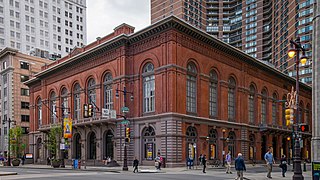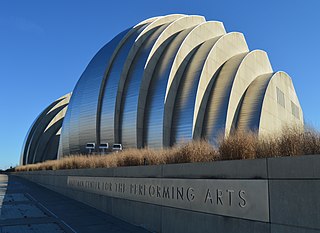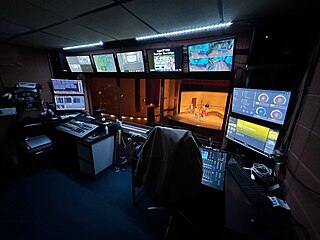Related Research Articles

The Dorothy Chandler Pavilion is one of the halls in the Los Angeles Music Center, which is one of the largest performing arts centers in the United States. The Music Center's other halls include the Mark Taper Forum, Ahmanson Theatre, and Walt Disney Concert Hall.

Oklahoma City University (OCU) is a private university historically affiliated with the United Methodist Church and located in Oklahoma City, Oklahoma.

The Academy of Music, also known as American Academy of Music, is a concert hall and opera house located at 240 S. Broad Street in Philadelphia, Pennsylvania. Despite its name, the Academy has never contained a music school. It is located between Locust and Manning Streets in the Avenue of the Arts area of Center City.

The Auditorium Theatre is a music and performance venue located in the Auditorium Building at 50 E. Ida B. Wells Drive in Chicago, Illinois. Inspired by the Richardsonian Romanesque Style of architect Henry Hobson Richardson, the building was designed by Dankmar Adler and Louis Sullivan and completed in 1889. The Chicago Symphony Orchestra performed in the theatre until 1904 as well as the Chicago Grand Opera Company and its successors the Chicago Opera Association and Chicago Civic Opera until its relocation to the Civic Opera House in 1929. The theater was home to the Joffrey Ballet from 1998 until 2020. It currently hosts a variety of concerts, musicals, performances, and events. Since the 1940s, it has been owned by Roosevelt University and since the 1960s it has been refurbished and managed by an independent non-profit arts organization.

The Maryland Theatre is a music and entertainment venue located in the Arts and Entertainment District of downtown Hagerstown, Maryland. It was built in 1915, partially destroyed by fire in 1974, reopened in 1978, and expanded into a full performing arts complex in 2019. The theatre's seating capacity is 1,279 people, and it hosts performances of symphony orchestras, country artists, comedians, children's shows, pop stars, recitals, stage shows, and others. Over 81,000 patrons attended performances at the Maryland Theatre in 2005, making it one of Maryland's premier venues for the performing arts. The Maryland Symphony Orchestra performs there regularly and has been headquartered in the building since 2019. The theater features a fully restored Wurlitzer theatre organ.

The Kauffman Center for the Performing Arts is in downtown Kansas City, Missouri, USA, at 16th and Broadway, near the city's Power & Light District, the T-Mobile Center and the Crossroads Arts District. Opened in 2011, it houses two venues: the 1,800-seat Muriel Kauffman Theatre, home of the Kansas City Ballet and Lyric Opera of Kansas City; and the 1,600-seat Helzberg Hall, home of the Kansas City Symphony Orchestra. Both venues host a variety of artists and performance groups in addition to these three resident entities.
Our Town is a three-act opera by composer Ned Rorem and librettist J. D. McClatchy. It is the first opera to be adapted from Thornton Wilder's 1938 play of the same name. The opera was commissioned by Indiana University Jacobs School of Music, Opera Boston, the Aspen Music Festival and School, North Carolina School of the Arts, Lake George Opera in Saratoga Springs, N.Y., and Festival Opera in Walnut Creek, Calif.

The control booth, control room, lighting box, technical booth, tech booth, or just booth used by television, film or theatrical technicians is the area designated for the operation of technical equipment, lighting controls and sound board. Often one or two followspots may be located in the booth as well. In a theater, it is generally an enclosed space with a large sliding window with a good view of the stage centered in the back of the house. It may be on the ground floor or at the balcony level. In a film or television production, it might be in a trailer or other space near the studio.

An atmospheric theatre is a type of movie palace design which was popular in the late 1920s. Atmospheric theatres were designed and decorated to evoke the feeling of a particular time and place for patrons, through the use of projectors, architectural elements and ornamentation that evoked a sense of being outdoors. This was intended to make the patron a more active participant in the setting.

The Wanda L Bass School of Music is a College at Oklahoma City University. It offers several degrees including; a BM, MM, and a BA in several areas of Music. The Bass School of Music at Oklahoma City University is an All-Steinway School, the nation’s first Conn-Selmer School, a member of the National Alliance for Music Theatre, and winner of ASCAP’s national orchestral award for adventurous programming of contemporary music.
The Sarah and Ernest Butler School of Music in the College of Fine Arts is located on the eastern side of The University of Texas at Austin.
The Roger L. Stevens Center is the primary performance venue in downtown Winston-Salem, North Carolina and is owned and operated by the University of North Carolina School of the Arts. It is named after the theatre producer and real estate magnate Roger L. Stevens and was opened on April 22, 1983. The venue serves the major UNCSA productions, the Winston-Salem Symphony, Piedmont Opera, and many other touring and local productions. All in all the theatre is used for rehearsal or performance all but 70 days of the year.

The University of Texas Performing Arts Center (PAC) is a collective of five theaters operated by The University of Texas at Austin, College of Fine Arts. The theaters are the Bass Concert Hall, McCullough Theater, Bates Recital Hall, B. Iden Payne Theater and Oscar Brockett Theater. Theaters range in size from the Oscar G. Brockett Theater, which has 244 seats, to the Bass Concert Hall, which seats 2,900. In addition to the theaters, the PAC also has offices and meeting rooms, rehearsal spaces and shops which are located in the PAC building and across the campus. PAC provides students an opportunity to interact with professionals in staging events and performing arts and extends an opportunity to the surrounding community to participate in all-age programs.

The Civic Center Music Hall is a performing arts center located in Oklahoma City, Oklahoma. It was constructed in 1937 as Municipal Auditorium and renamed in 1966. The facility includes the Thelma Gaylord Performing Arts Theatre, the Freede Little Theatre, CitySpace, the Meinders Hall of Mirrors and the Joel Levine Rehearsal Hall.

The Pioneer Center for the Performing Arts is a theater located in Reno, Nevada. It was designed by the Oklahoma City architectural firm of Bozalis, Dickinson and Roloff as a concrete structure with a distinctive gold geodesic dome roof. The facility was completed in 1967 with 987 seats on the main level and 513 seats in a balcony, totaling to 1,500. The co-founder of Temcor, the project's contractor, was Don Richter, a student of Buckminster Fuller, developer of the geodesic dome concept. Temcor had built several gold-anodized aluminum domes before the Pioneer, and was responsible for more than 5000 dome projects.
The Oakridge School is a private school located in Arlington, Texas, US. It educates about 800 students in age groups Preschool-12.
The Daryl Chase Fine Arts Center is a multi-venue visual and performing arts complex on the campus of Utah State University. It is named for Daryl Chase, the tenth president of USU, who served from 1954 to 1968.

The Joe R. and Teresa Lozano Long Center for the Performing Arts is a performing arts venue located along Lady Bird Lake in downtown Austin, Texas. The Long Center is the permanent home of the Austin Symphony Orchestra, Austin Opera and Ballet Austin and hosts other Austin-area performing arts organizations.
Wanda L. Bass was an American philanthropist and banker. Bass donated most of the $38.5 million for the Wanda L. Bass School of Music at Oklahoma City University. In addition, she gave a separate $2.1 million gift to purchase 105 Steinway pianos. Bass was noted for her donations of time and money to the McAlester Public Schools and numerous other causes in Oklahoma.

The UCLA Herb Alpert School of Music, located on the campus of the University of California, Los Angeles, is “the first school of music to be established in the University of California system.” Established in 2007 under the purview of the UCLA School of Arts and Architecture and the UCLA Division of Humanities, the UC Board of Regents formally voted in January 2016 to establish the school. It is supported in part by a $30 million endowment from the Herb Alpert Foundation.